Niching down means focusing your business on serving a specific, narrow group of customers instead of appealing to everyone. It’s the strategic decision to become the go-to expert for a particular audience rather than being mediocre for the masses.
Instead of “I target small businesses,” you say “I help local bakeries with 3-15 employees improve their inventory management.”
–
For the 2-step niching down method, jump to this section.
If you’re looking for ways to validate your niche, go here.
To craft laser-focused positioning and messaging, go here.
–
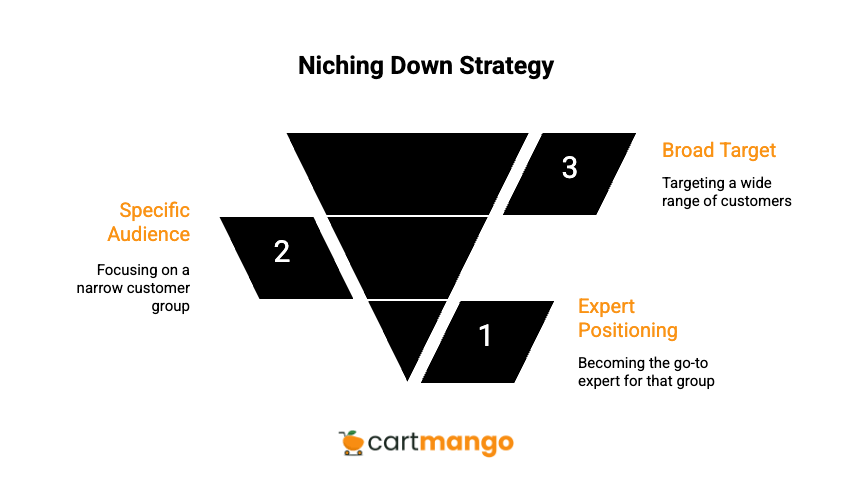
The myth that niches are too small to scale is wrong. A well-chosen niche gives you a launching pad, not a prison cell.
Companies that narrowed their offer around a single specialty reported an average 61% jump in profit after the change (Source: ActionCoach).
The 2-Step SPCM Method to Niche Down
Before you can niche down, know what you bring to the table.
Below is a two-part audit that reveals your sweet spot and prevents you from chasing opportunities that don’t align with your strengths.
SP = Skills and passion
CM = Competitive Moat
Step 1: Skills-and-Passion Matrix (SP)
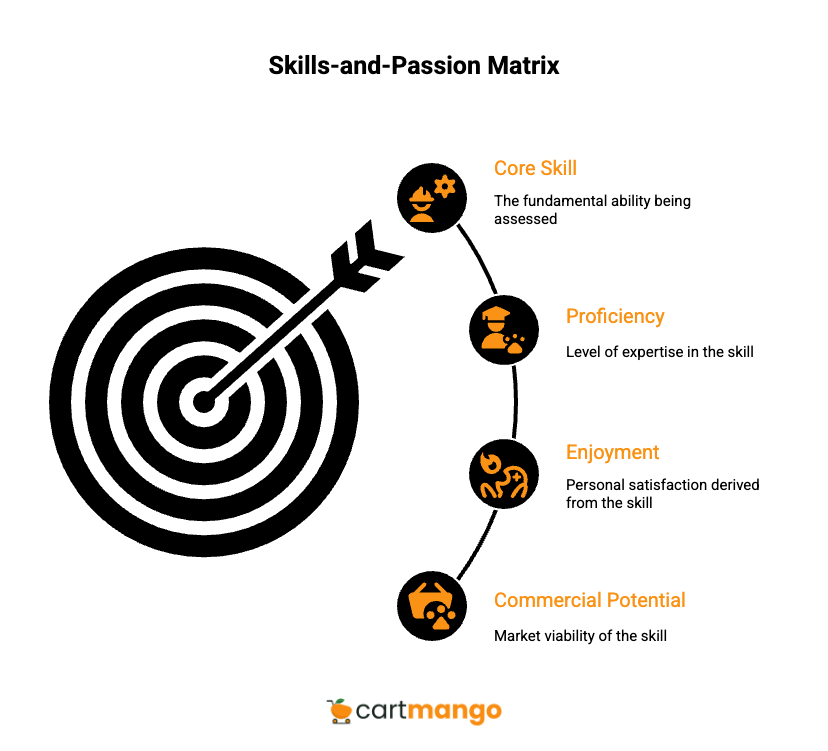
This exercise forces you to face the truth about what you’re good at and what energizes you. Too many entrepreneurs build businesses around skills they hate or lack proficiency in, leading to burnout and poor results.
Fill out this matrix for every skill you possess (below is an example):
Core Skill (e.g.) | Proficiency (1–5) | Enjoyment (1–5) | Commercial Potential? (Y/N) |
|---|---|---|---|
UX copywriting | 5 | 4 | Y |
Python data automation | 4 | 3 | Y |
Motion-graphics editing | 2 | 5 | Y |
B2B sales outreach | 3 | 2 | Y |
Mindfulness coaching | 1 | 4 | Y |
Reciting movie credits in order | 4 | 5 | N |
Collecting novelty erasers | 3 | 4 | N |
Short-list any skill scoring 4-5 in both numbered columns and marked “Y” for Commercial Potential.
Why the two skills are marked “N”:
- Reciting movie credits in order: Fun party trick but no steady job market, freelance demand, or monetized communities.
- Collecting novelty erasers: Low secondary-market value and no dedicated paid services around the hobby.
The scoring works like this:
For proficiency:
- 1 means basic awareness
- 2 means beginner level
- 3 means competent
- 4 means advanced
- 5 means expert
For enjoyment:
- 1 means you avoid it
- 2 means mild interest
- 3 means neutral
- 4 means you look forward to it
- 5 means you lose track of time doing it
–
Step 2: Competitive-Moat Scorecard (CM)
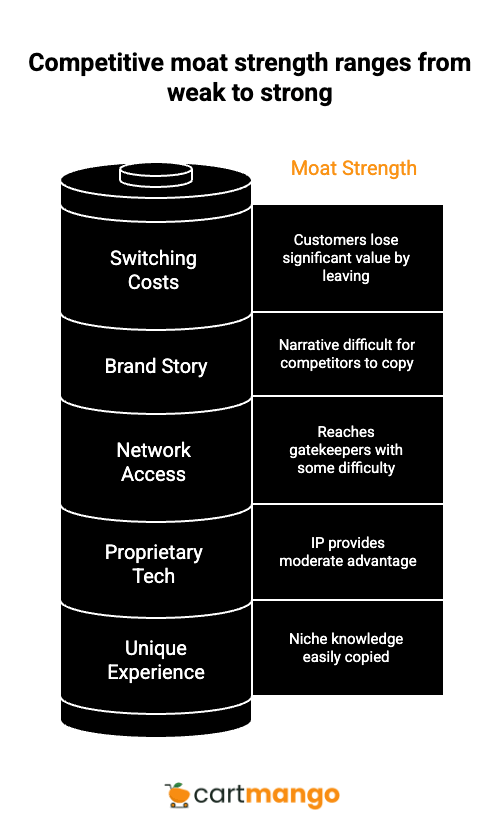
Now assess your defensibility against competitors. This step separates businesses that thrive from those that struggle with commoditization and price wars.
Rate each factor from 1-3:
Moat Factor | Question to Ask | Score (1–3) |
|---|---|---|
Unique experience | “Do I have niche knowledge competitors lack?” | |
Proprietary tech/process | “Is there IP only I control?” | |
Network access | “Can I reach gate-keepers others can’t?” | |
Brand story | “Is my narrative difficult to copy?” | |
Switching costs | “Would customers lose value by leaving?” | |
Total | (max 15) |
Scoring guide:
- 1 = Weak, easily replicated
- 2 = Moderate, some advantage
- 3 = Strong, hard to imitate
If you score 12-15, you have a robust moat. Between 8-11 means moderate defensibility. Below 8 suggests you need to strengthen your position or pick a different niche.
The most successful niche businesses score high on at least two factors. A consultant friend scores 3 on unique experience (former Fortune 500 CFO) and 3 on network access (still has relationships with C-suite executives). Those two factors alone let him charge premium rates.
How to Spot Profitable Sub-Niches
Finding your niche requires both art and science. Use a systematic four-step process that weeds out dead ends before you waste time on them.

1/ Quantitative Signals
Check keyword volume, cost-per-click, and difficulty scores using tools like Ahrefs or Semrush. You want decent search volume (at least 500 monthly searches) without crushing competition.
Use these as guidelines:
- Monthly search volume: 500-5,000 (sweet spot for most niches)
- Cost-per-click: $2-15 (indicates commercial intent)
- Keyword difficulty: Under 40 (achievable)
Calculate your total addressable market with this formula:
TAM (Total Addressable Market) = users × average revenue per user.
If your TAM falls below $1 million, you might be too narrow.
2/ Qualitative Discovery
Qualitative discovery reveals the human side of the data.
I call this a “problem safari.” Spend time in Reddit threads, Discord servers, and Slack communities. This audience research guide should help.
The gold you’re mining for? Repeated complaints about problems that don’t have good solutions. When you see the same frustration voiced multiple ways across different platforms, you’ve found pain worth solving.
Here’s my problem safari checklist:
- Join 3-5 relevant communities
- Spend 2 hours reading posts and comments
- Note recurring complaints and language patterns
- Screenshot particularly emotional responses
- Identify gaps where existing solutions fall short
Run five Jobs-To-Be-Done interviews to validate willingness to pay. The Harvard Business Review’s JTBD primer walks you through the process.
3/ Trend Validation
This prevents you from building on quicksand. Use Google Trends to confirm interest has been stable or growing over three years. Avoid anything that looks like a fad.
4/ Competitive Sweep
This completes the picture. A few established players signal real demand. But if every search result shows a crowded field, you’re probably looking at a red ocean.
Validating Your Niche
Here’s a quick reference before diving into the details:
Step | Action | Goal |
|---|---|---|
1 | Survey 30+ users | Rank pain points |
2 | Pre-sell solution | Prove purchase intent |
3 | Calculate break-even | Confirm viability |
4 | Pivot or iterate | Course correct |
5 | Beta launch | Refine positioning |
I’ve learned the hard way that assumptions kill businesses. This framework forces you to test your ideas before you invest serious time and money.
Step 1: Survey At Least 30 Target Users
Rank their biggest pains. Use tools like Google Forms or Typeform.
I’d ask this question: “If you could wave a magic wand and solve one problem related to [your niche], what would it be?”
Don’t skip this step because you think you know what people want. We once spent four months building a feature that exactly three people requested, while ignoring the problem that 47 people mentioned.
The survey should also include:
- How much time/money this problem costs them monthly
- What solutions they’ve already tried
- What would need to be true for them to pay for a solution
- How they currently work around the problem
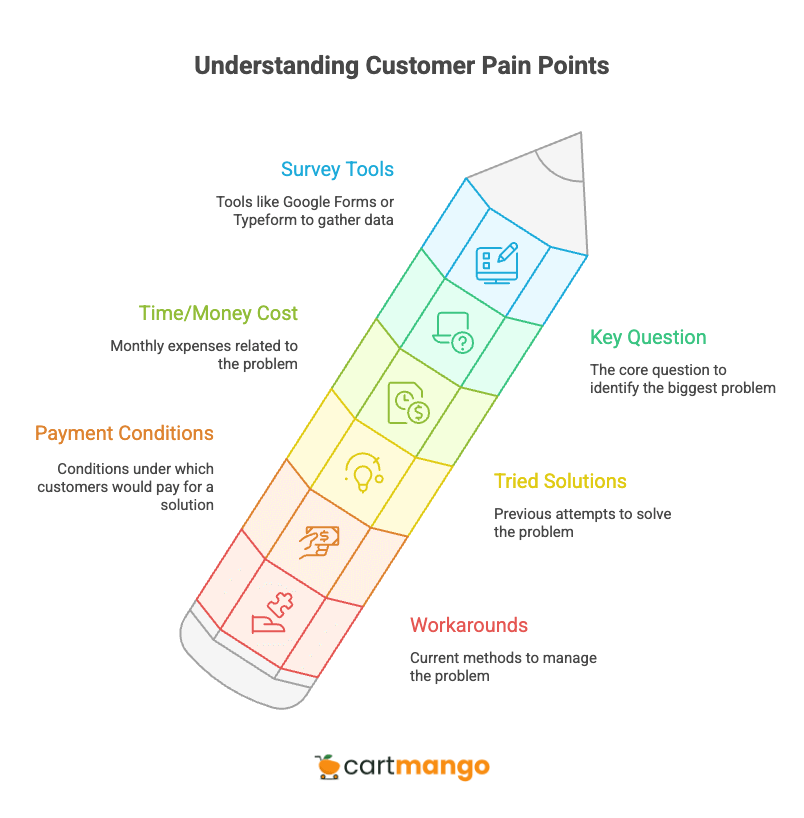
Step 2: Pre-Sell Before Building
Create a concierge MVP, mini-course, or paid workshop. The goal isn’t perfect delivery, it’s proof that people will pay for your solution.
Your pre-sell can be:
- A detailed outline of your solution with early-bird pricing
- A “done-for-you” version where you provide the service manually
- A workshop that teaches the methodology you plan to productize
- A consultation package that validates your expertise
Step 3: Calculate Your Break-Even Point
Use this formula: target sales = fixed costs ÷ (price – variable costs).
If you need to sell 1,000 units to break even but your entire addressable market is 500 people, you have a problem.
Include all costs in your calculation:
- Software subscriptions and tools
- Marketing and advertising spend
- Your time at a reasonable hourly rate
- Customer acquisition costs
- Refunds and chargebacks
Step 4: Decide to Pivot or Iterate
Decide based on feedback. Don’t get married to your first idea. The market will tell you what it wants if you listen.
Sometimes the pivot is small. A business targeting “busy moms” realized through feedback that “working moms with kids under 5” was the real sweet spot.
Sometimes it’s bigger. Another business switched from productivity software to productivity consulting after discovering people wanted done-for-you services, not another tool.
Red flags that suggest a pivot:
- Less than 20% of survey respondents show strong interest
- No one pre-purchases despite multiple attempts
- Break-even requires unrealistic sales volumes
- Negative feedback focuses on the core concept, not execution
Step 5: Launch your beta version
Collect testimonials, refine your positioning, and document what works. This becomes the foundation for your launch.
The beta phase isn’t about perfection. It’s about learning what resonates and what falls flat. Every piece of feedback is data you can use to improve your offering.
Beta launch checklist:
- Deliver the minimum viable version of your solution
- Over-communicate with early customers
- Ask for detailed feedback after each interaction
- Document successful outcomes as case studies
- Refine your messaging based on what customers say
Crafting Laser-Focused Positioning & Messaging
Your positioning determines whether prospects see you as the obvious choice or just another option. I use a simple template that cuts through the noise.
Positioning Template
“I help [who] achieve [outcome] without [pain].”
For example: “I help busy pediatricians improve their patient intake process without hiring additional staff.”
The template works because it addresses 3 critical questions every prospect has:
- Am I the right fit? (who)
- What’s in it for me? (outcome)
- What’s the catch? (without pain)

Messaging Flow
This connects features to emotions. List each feature of your solution. Map it to a concrete benefit. Then tie that benefit to the core emotion it triggers.
Example 1:
- Feature: Automated appointment reminders
- Benefit: 40% fewer no-shows
- Emotion: Relief from lost revenue stress
Example 2:
- Feature: Pre-visit questionnaires
- Benefit: 15 minutes saved per appointment
- Emotion: Control over hectic schedule

Voice Consistency
This matters more than perfect grammar.
Mirror the exact phrases you collected during your interviews and community research. When your copy sounds like your customer’s internal monologue, they feel understood.
I’ve seen businesses improved their results by changing a single word in their positioning. A consultant switched from “marketing strategy” to “revenue strategy” and saw inquiry rates increase by 20%. Same service, different emotional trigger.
Common positioning mistakes to avoid:
- Using jargon your customers don’t use
- Focusing on features instead of outcomes
- Being too broad (“I help everyone”)
- Ignoring the emotional component
- Copying competitor messaging
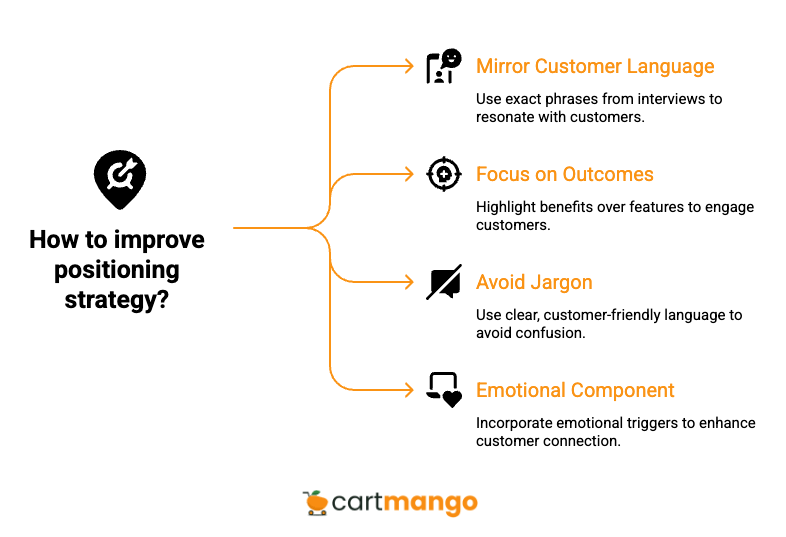
Common Pitfalls (& their antidodes)
Pitfall | Antidote |
|---|---|
Chasing a fad | Validate with a three-year Google Trends curve |
Niche too tiny | Make sure TAM is at least $1 million and that adjacent “bowling-pin” niches exist |
Scaling too soon | Set KPI gates (like LTV:CAC ratio above 3:1) before broadening |
Fad-chasing feels exciting but leads to heartbreak. Remember fidget spinners? Cryptocurrency trading courses? Pokemon Go accessories? The smart money waited for proof of staying power.
I watch entrepreneurs get caught up in the excitement of trending topics without asking whether the trend has legs. The three-year test filters out most fads while preserving real opportunities.
Tiny niches can’t support a real business. If your total addressable market can fit in a small conference room, you need to zoom out slightly.
The bowling-pin strategy helps here. Start with one narrow niche, then expand to adjacent niches once you’ve proven your model. A consultant who starts with “SaaS companies with 50-100 employees” can later expand to “SaaS companies with 25-50 employees” and “SaaS companies with 100-200 employees.”
Premature scaling dilutes your message right when you’re gaining traction. Master one niche completely before expanding to adjacent ones.
Many businesses lose their competitive advantage by trying to serve too many audiences at once. The clear, focused message that helped them win their first niche becomes diluted as they try to appeal to everyone.
Beyond the Basics: Scaling Your Niche Market
Once you’ve established your foothold, the business world opens up in ways most people never experience. Your niche market becomes the foundation for business success that extends far beyond your initial segment.
I’ve seen people transform their new business from serving a single target audience to commanding respect across multiple industries. The difference isn’t just about making more money (though that happens). It’s about gaining the clarity and freedom that comes from true expertise.
Consider these practical steps for growth. Someone who started helping accounting firms with workflow automation eventually expanded to serve law firms, then medical practices. Same core systems, different applications. The internet made it possible to reach these segments without massive investment in traditional marketing.
The better way to think about expansion is this: your initial niche market gives you credibility to explore adjacent opportunities. When you talk to prospects in related industries, you’re not starting from zero. You have case studies, testimonials, and proven methodologies.
Key expansion strategies:
- Leverage existing clients for referrals to similar industries
- Adapt your core solution for different business contexts
- Use digital products to serve broader audiences while maintaining focus
The Modern Tools Advantage: Digital Products and Automation
The modern business world rewards those who understand how automation can amplify their niche expertise. Most people struggle because they try to scale through manual effort alone, but there’s a smarter approach.
Digital products transform how you serve your target audience. For instance, a consultant who specialized in helping restaurants optimize their supply chains created an online course that reached thousands of restaurant owners. The same level of expertise, but delivered through the internet to generate passive income.
Here’s another example that illustrates this perfectly: A financial advisor who focused exclusively on dentists built a software tool that automated retirement planning calculations for dental practices. Instead of serving 50 clients individually, his tools now serve 500+ practices while he focuses on high-touch strategic advice.
I’ve seen this pattern repeatedly: professionals who embrace modern systems effectively can serve more clients without sacrificing quality. The key is maintaining the personal connection that made your niche market successful in the first place.
Automation considerations for niche businesses:
- Workflow tools that free up time for high-value activities
- Online course platforms for scaling your expertise
- CRM systems designed for your specific industry
- Analytics tools to track growth and client satisfaction
The advice here is simple: use systems to ENHANCE your human expertise, not replace it. Your clients value the personal touch that comes from understanding their specific challenges.
The Lifestyle Impact: Freedom Through Focus
This article has covered the tactical aspects of niching down, yet I want to talk about something equally important:
How this approach changes your life.
When you dominate a niche market, you gain a sense of control that’s rare in the business world. You’re not constantly chasing new trends or competing on price. Your clients seek you out because you solve their specific problems better than anyone else.
The freedom this creates is huge. You can choose your clients, set your rates, and structure your work around your life instead of the other way around. Most people in business never reach this level of autonomy.
Lifestyle benefits of niche mastery:
- Higher rates due to specialized expertise
- Better work-life balance from serving ideal clients
- Reduced stress from clear positioning and messaging
- More time to explore new opportunities and interests
- Greater satisfaction from making a real difference
Remember that business success isn’t just about revenue growth. It’s about creating a sustainable practice that serves your target audience while giving you the life you want.
The rest of your journey will be about refinement and expansion. You’ll discover new segments within your niche, develop additional digital products, and build deeper relationships with your clients. But the foundation you’re building now: the clarity, focus, and expertise… they will serve you for years to come.
The world needs specialists who understand specific problems deeply. By choosing to serve a niche market effectively, you’re not just building a business. You’re creating value that makes a real difference in people’s lives.
FAQ
Can I pivot niches later?
Yes, but do it strategically. You can reuse your audience insights and reposition without losing all your momentum. The key is finding connections between your old and new niches.
E.g. A business could pivot from “productivity for remote workers” to “productivity for working parents” by recognizing that 70% of their audience fell into both categories. They can keep the same core methodology but adjusted the messaging and examples.
What if a big competitor enters my niche?
Double down on your moat factors and deepen your community ties. Big companies often struggle with the personal touch that makes niche businesses special.
How small is too small?
If your TAM is under $1 million and you can’t identify logical adjacent niches for future expansion, long-term sustainability becomes questionable.
But don’t let this scare you away from truly narrow niches. A $1 million TAM can support a very profitable business if you capture a huge share of it.
Your 90-Day Action Plan to Niching Down
Building a niche business takes time and patience. Here’s a realistic timeline that accounts for the challenges you’ll face:
Month 1: Foundation & Research
- Week 1-2: Complete the Skills-and-Passion Matrix and Competitive-Moat Scorecard
- Week 3: Research three potential niches using keyword tools and community exploration
- Week 4: Choose one niche and begin deeper market research
Month 2: Validation & Testing
- Week 5-6: Create and distribute your validation survey, aim for 30+ responses
- Week 7: Analyze survey results and adjust your approach based on feedback
- Week 8: Design your pre-sell offer and begin outreach to potential customers
Month 3: Launch & Iterate
- Week 9-10: Launch your beta version to early customers who pre-purchased
- Week 11: Collect detailed feedback and refine your positioning
- Week 12: Document case studies, set KPI gates, and plan your next 90-day cycle
Reality check:
Most successful niche businesses take 6-12+ months to gain real traction. Don’t expect overnight success, but do expect steady progress if you follow this systematic approach.
The path forward isn’t about restricting yourself. It’s about choosing your battles wisely. When you niche down, you’re not thinking smaller. You’re thinking clearer.
Related
- SamCart vs ClickFunnels: The Recurring Revenue Hostage (2026)
- SendOwl vs ThriveCart: Which has a hidden trap in 2026?
- SendOwl vs SamCart: The Recurring Revenue Jail (2026)
- ThriveCart vs ClickFunnels: When more features hurt (2026)
- SendOwl vs Payhip: The “You-Leave-You-Lose” Model (2026)
- SamCart vs Kajabi: The Income Hostage Trap (2026)
- Sellfy vs Payhip: The Recurring Revenue Prison (2026)
- Podia vs Gumroad: The Recurring Revenue Handcuffs (2026)
- SendOwl vs Gumroad: The Recurring Revenue Black Hole (2026)
- Gumroad vs Sellfy: The Vendor Lock-in Cage (2026)
